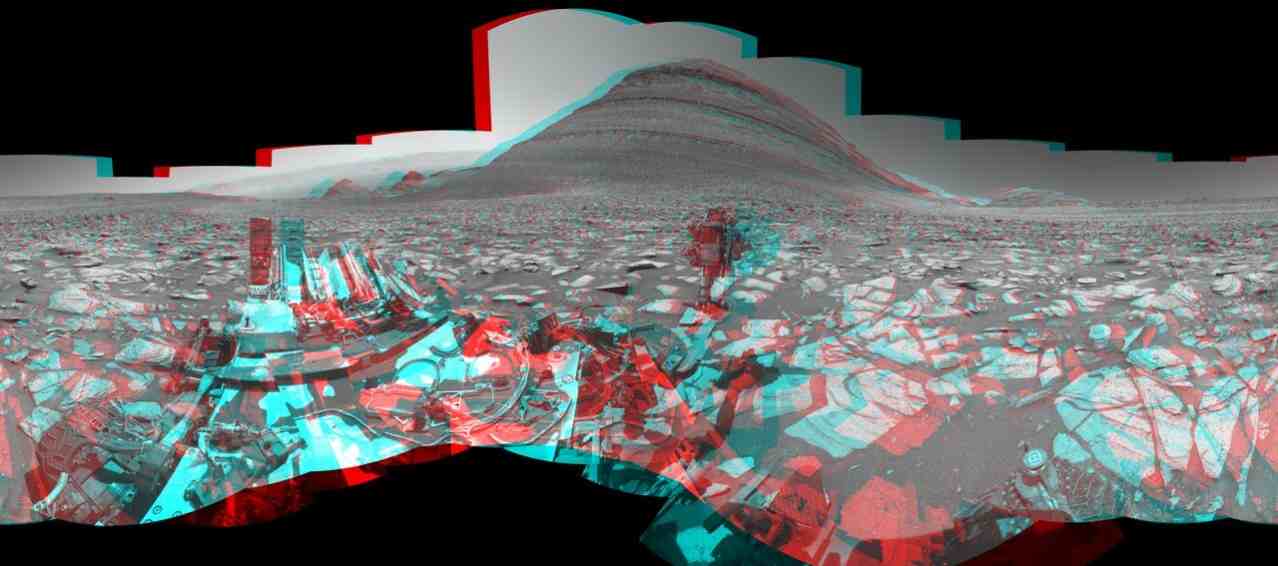Four thousand Martian days after setting its wheels in Gale Crater on Aug. 5, 2012, NASA’s Curiosity rover remains busy conducting exciting science. The rover recently drilled its 39th sample, then dropped the pulverized rock into its belly for detailed analysis.
To study whether ancient Mars had the conditions to support microbial life, the rover has been gradually ascending the base of 3-mile-tall (5-kilometer-tall) Mount Sharp, whose layers formed in different periods of Martian history and offer a record of how the planet’s climate changed over time.
The latest sample was collected from a target nicknamed “Sequoia” (all of the mission’s current science targets are named after locations in California’s Sierra Nevada). Scientists hope the sample will reveal more about how the climate and habitability of Mars evolved as this region became enriched in sulfates—minerals that likely formed in salty water that was evaporating as Mars first began drying up billions of years ago. Eventually, Mars’s liquid water disappeared for good.
“The types of sulfate and carbonate minerals that Curiosity’s instruments have identified in the last year help us understand what Mars was like so long ago. We’ve been anticipating these results for decades, and now Sequoia will tell us even more,” said Ashwin Vasavada, Curiosity’s project scientist at NASA’s Jet Propulsion Laboratory in Southern California, which leads the mission.

NASA’s Curiosity Mars rover used the drill on the end of its robotic arm to collect a sample from a rock nicknamed “Sequoia” on Oct. 17, 2023, the 3,980th Martian day, or sol, of the mission. The rover’s Mastcam captured this image. Credit: NASA/JPL-Caltech/MSSS
Deciphering the clues to Mars’ ancient climate requires detective work. In a recent paper published in the Journal of Geophysical Research: Planets, team members used data from Curiosity’s Chemistry and Mineralogy (CheMin) instrument to discover a magnesium sulfate mineral called starkeyite, which is ᴀssociated with especially dry climates like Mars’s modern climate.
The team believes that after sulfate minerals first formed in salty water that was evaporating billions of years ago, these minerals transformed into starkeyite as the climate continued drying to its present state. Findings like this refine scientists’ understanding of how the Mars of today came to be.
Time-tested rover
Despite having driven almost 20 miles (32 kilometers) through a punishingly cold environment bathed in dust and radiation since 2012, Curiosity remains strong. Engineers are currently working to resolve an issue with one of the rover’s main “eyes”—the 34 mm focal length left camera of the Mast Camera (Mastcam) instrument. In addition to providing color images of the rover’s surroundings, each of Mastcam’s two cameras helps scientists determine from afar the composition of rocks by the wavelengths of light, or spectra, they reflect in different colors.

This anaglyph version of Curiosity’s panorama taken at “Sequoia” can be viewed in 3D using red-blue glᴀsses. Credit: NASA/JPL-Caltech
To do that, Mastcam relies on filters arranged on a wheel that rotates under each camera’s lens. Since Sept. 19, the left camera’s filter wheel has been stuck between filter positions, the effects of which can be seen on the mission’s raw (unprocessed) images. The mission continues to gradually nudge the filter wheel back toward its standard setting.
If unable to nudge it back all the way, the mission would rely on the higher-resolution 100 mm-focal length right Mastcam as the primary color-imaging system. As a result, how the team scouts for science targets and rover routes would be affected: The right camera would have to take nine times more images than the left to cover the same area. The teams also would have a degraded ability to observe the detailed color spectra of rocks from afar.
Along with efforts to nudge the filter back, mission engineers continue to closely monitor the performance of the rover’s nuclear power source and expect it will provide enough energy to operate for many more years. They have also found ways to overcome challenges from wear on the rover’s drill system and robotic-arm joints. Software updates have fixed bugs and added new capabilities to Curiosity, too, making long drives easier for the rover and reducing wheel wear that comes from steering (an earlier addition of a traction-control algorithm also helps reduce wheel wear from driving over sharp rocks).
Meanwhile, the team is preparing for a break of several weeks in November. Mars is about to disappear behind the sun, a phenomenon known as solar conjunction. Plasma from the sun can interact with radio waves, potentially interfering with commands during this time. Engineers are leaving Curiosity with a to-do list from Nov. 6 to 28, after which period communications can safely resume.
Reference:
S. J. Chipera et al, Mineralogical Investigation of Mg‐Sulfate at the Canaima Drill Site, Gale Crater, Mars, Journal of Geophysical Research: Planets (2023). DOI: 10.1029/2023JE008041





